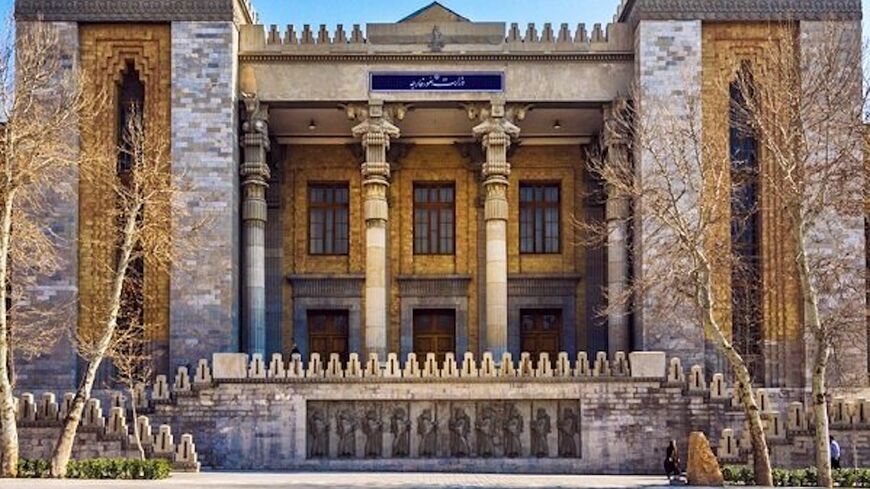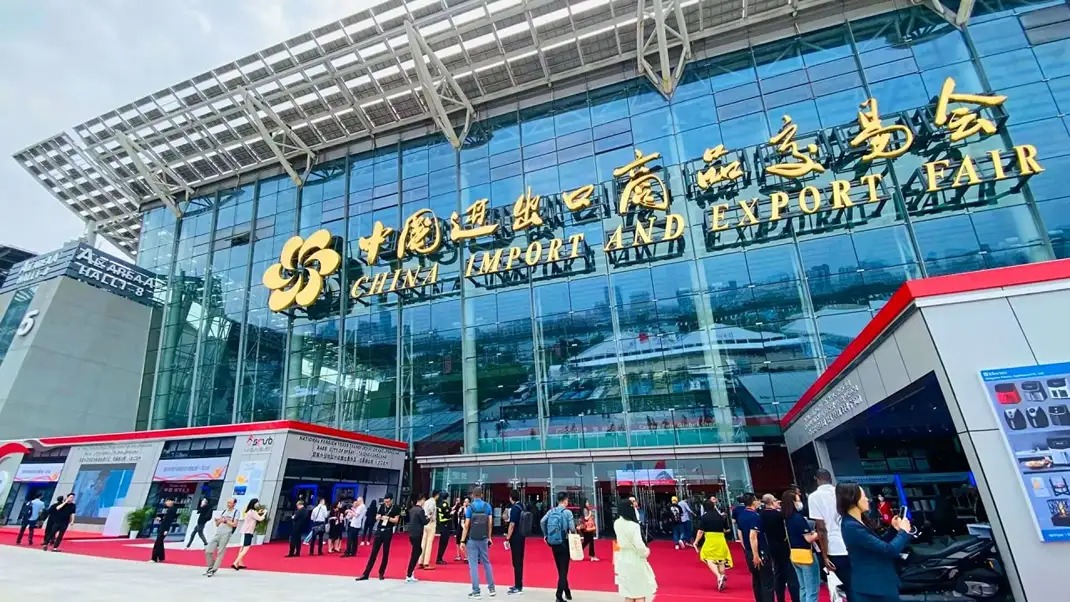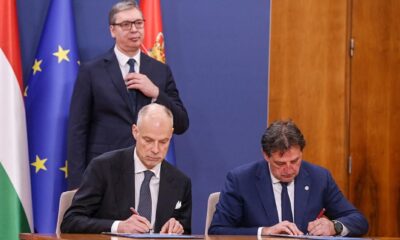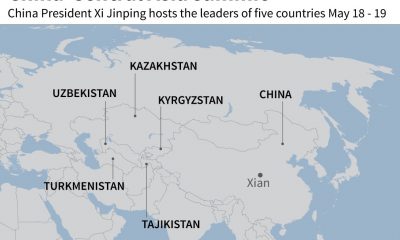Asia
Taliban officials take over Afghan embassy in Iran

Iran has officially handed the Afghan embassy in Tehran over to the Taliban, becoming the first country to accept the Taliban appointed ambassador but yet to recognize its government.
The Taliban foreign ministry said a seven-member team of “experienced diplomats,” led by a newly appointed chargé d’affaires” have arrived in Tehran to formally assume the office.
The ministry called the move an important step in improving bilateral relations between the two neighboring countries.
“We believe that with the new appointments, we would witness transparency in the affairs of the embassy as well as expanded relations in various fields between the two Muslim and brotherly countries,” the ministry spokesman Abdul Qahar Balkhi said.
Iran did not provide details, but termed the development as an internal issue of Afghanistan.
“The issue of handing over and transformation of the Afghan embassy in Tehran is an internal matter (related to Afghanistan) and the Ministry of Foreign Affairs of Iran has not entered into the matter by any means,” Meher quoted a statement from the ministry.
“Iran’s Ministry of Foreign Affairs has not received any document or equipment or any other object belonging to the Afghan Embassy in Tehran,” it added.
Opposition condemns the move
The National Resistance Front (NRF) of Afghanistan, the opposition party, has strongly condemned Iran’s move in ceding the Afghan embassy to the Taliban.
A spokesperson of NRF, Sibghatullah Ahmadi in a statement said that this action was taken despite the Front’s concerns about its adverse consequences.
“Nonetheless, [Iran] allowed the representatives of the illegitimate and the terrorist group of Taliban to enter the diplomatic mission of Afghanistan,” the statement added.
The statement furthered that the political presence of the Taliban in Iran, with its “dark history” is “perilous”, especially for the millions of refugees in the country.
Good ties with both
It is worth mentioning that Iran has good relations with the Taliban as well as with NRF, composed of more Tajki people who announced war against the Taliban.
Since the return of the Taliban into power in 2021, no country has so far recognized them. However, Pakistan and Russia were the first countries that handed over the Afghan embassy to the Taliban. The third is now Iran.
It has been said that other countries like China, Uzbekistan, Malaysia, Kyrgyzstan and Kazakhstan have allowed the Taliban to appoint staff to manage the diplomatic missions, but they did not completely hand them over to them.
At the same time, a large number of Afghanistan’s diplomatic missions around the world are active and open for every kind of business, and the host country is yet to decide on whether to hand it over to the Taliban.
Many countries refused to hand them over because they don’t want to work with the Taliban at the moment.
Culture ties between Afghanistan and Iran
Afghanistan and Iran share many cultural ties and even they speak the same language (Persian or Dari). Dari is one of the official languages in Afghanistan, and mostly spoken ever. All the statements were in Dari or in Pashto, the second largely spoken language in the country.
Iran and Afghanistan also celebrate Nowruz, the Persian New Year, and also there are millions of Afghans living in Iran and many of them don’t have legal stay documents.
But, when the Taliban seized power for the first time in the 90s, relations between Afghanistan and Iran strained after killing some Iranian diplomats.
However, now that the Taliban returned to power in 2021, Kabul and Tehran have opened trade, other commercial relations and also top Taliban officials visited Iran.
No recognitions yet
The Western countries did not recognize the Taliban yet, putting human rights and giving women access to education and work as the main demand for their recognition. They also asked for formation of an inclusive government representing all groups in Afghanistan.
Meanwhile, Shahabuddin Delawar, the acting minister of Mines and Petroleum said that the current government is bound by all its commitments to the world.
“The world also needs good interaction with Afghanistan and the world cannot ignore Afghanistan’s geographical location and the people of Afghanistan,” Delawar told a local news agency TOLOnews
Islamic Emirate is committed to the rights of all citizens of the country, he added.
Moreover, former US special envoy Zalmay Khalilzad said that the human rights situation and women’s rights to education and work is important for the international community and for the US.
The Taliban have barred women from workplaces and girls from schools and universities since they gained power in 2021. The international community has strongly reacted to the action and called on the Taliban to immediately reverse its decision and let the women and girls work and study.
Asia
China’s economy exceeds expectations with 5.4% growth in first quarter

China’s economy surpassed expectations in the first quarter, driven by robust consumption and industrial production.
According to data released on Wednesday, China’s gross domestic product (GDP) grew by 5.4% year-on-year in the January-March quarter, exceeding the 5.1% increase expected by analysts polled by Reuters.
Xu Tianchen, a senior economist at the Economist Intelligence Unit, described the 5.4% growth rate as “a very good start,” noting that government stimulus had boosted consumption and supported investment.
“In each of the past two years, China’s first quarter has been high, and the second quarter has been low,” Xu said, adding that a “strong and timely policy response” was needed, given the additional pressure from US tariffs.
Exports helped support growth last year, even as a trillion-dollar trade surplus, a prolonged real estate sector slump, and sluggish domestic demand continued to undermine a solid recovery.
Chinese Premier Li Qiang said this week that the country’s exporters would have to cope with “profound” external changes and pledged to support greater domestic consumption.
According to Reuters, analysts are concerned that US tariffs could lead to a sharp decline in the momentum China has gained.
The economy is expected to grow at an annual rate as low as 4.5% in 2025, slowing from last year’s 5.0% pace and falling short of the official target of around 5.0%, according to a Reuters poll. Many analysts have sharply lowered their GDP forecasts for this year.
On Wednesday, ANZ lowered its China 2025 GDP forecast from 4.8% to 4.2% and its 2026 forecast from 4.5% to 4.3%, citing punitive US tariffs.
UBS painted an even more pessimistic picture this week, cutting its 2025 growth forecast for the Asian giant from 4% to 3.4%, assuming continued increases in China-US tariffs and additional stimulus from Beijing.
“We believe the tariff shock poses unprecedented challenges for China’s exports and will also lead to a major adjustment in the domestic economy,” UBS analysts said in a note.
While many other countries are covered by US tariffs, Trump has targeted China for the largest tariffs.
Last week, Trump’s move to raise tariffs on China by 145% led to Beijing raising tariffs on US goods by 125%.
Unemployment and deflation issues
The escalating trade war with the US overshadowed some of the brighter notes in separate data.
Retail sales, a key indicator of consumption, rose 5.9% year-on-year in March, after increasing 4.0% in January-February, while growth in factory output accelerated to 7.7% from 5.9% in the first two months. Both figures exceeded analysts’ forecasts.
The increase in retail sales was driven by sharp double-digit increases in sales of home electronics and furniture, aided by the government’s consumer goods trade-in program.
However, the decline in China’s real estate sector continued to be a drag on overall growth.
Real estate investment fell 9.9% year-on-year in the first three months, widening from a 9.8% drop in January-February. New home prices in March were unchanged from the previous month.
Data released on Wednesday indicated that the economic recovery is still uneven, particularly as high unemployment and persistent deflationary pressures raise concerns about weak demand.
“A good GDP does not represent the overall economic health of an economy,” said Raymond Yeung, chief China economist at ANZ. “Deflation and youth unemployment remain major concerns,” he added.
Broad policy measures required
Moreover, analysts believe that the increase in China’s exports in March—driven by factories rushing shipments to beat Trump’s latest tariffs—could sharply reverse in the coming months as heavy US tariffs take effect.
Analysts expect further support measures in the coming months, following monetary easing steps taken late last year.
Earlier this month, Fitch downgraded China’s credit rating, citing rapidly growing public debt and risks to public finances, signaling a difficult balancing act for policymakers seeking to expand consumption in the face of declining trade.
“The current situation is similar to the negative shocks China has experienced in the past, such as the COVID-19 pandemic in 2020 and the global financial crisis in 2008,” said Yeung from ANZ.
“We see limited options for Chinese authorities other than a major fiscal expansion to counter the tariff shock,” he assessed.
Asia
China trade fair: US market ‘frozen’ amid tariff hikes

Candice Li, attending the China trade fair in Canton, says that US orders for her firm’s medical devices have dried up after Washington increased tariffs on Chinese goods by 145%.
Speaking to Reuters, Candice Li, marketing manager at Conmo Electronic Co., said, “This is a matter of life and death because 60%-70% of our business is with American clients.” She added, “Goods cannot be exported, and money cannot be collected. This is a very serious situation.”
Li was at her firm’s booth at the Canton Fair in the southern city of Guangzhou, China’s largest trade fair, held twice a year, where more than 30,000 participants display their products in an area larger than 200 soccer fields.
This fair is the first China has held since US President Donald Trump introduced tariffs earlier this month, exceeding 100% for China and at least 10% for the rest of the world.
Most of the exporters Reuters spoke with said that US orders, vital for firms like Li’s, were either delayed or not arriving—a bad sign for the world’s second-largest economy, whose growth last year relied heavily on its trillion-dollar trade surplus.
No other country comes close to China’s sales of over $400 billion in goods to the US annually.
Even though the tariffs Trump will impose on the rest of the world are much lower, they are likely to reduce global demand in the coming months and, indirectly, the appetite for Chinese goods in other countries.
Kobe Huang, a sales representative for Shenzhen Landun Environmental Technology, which produces water filters and smart toilets, said at the China trade fair in Canton that European sales are up for now, but the US market is “frozen.”
“US clients and distributors haven’t canceled orders, but they’ve asked us to wait. So, we’re holding on,” he stated.
Levy Spence, a US importer and president of Air Esscentials, said, “Prices will go up.” He added, “Even for products we source in the United States, many of the raw materials come from all over the world. It’s not just about China tariffs.”
Organizers noted that approximately 170,000 overseas buyers had registered for this month’s fair as of April 8, compared to a record attendance of 253,000 at the previous fair, which ended in November. About 10% of these attendees come from the US and Europe, whereas the previous rate was about 20%.
The fair will take place from April 15 to May 5. Local media reported that a total of $25 billion in deals were made at the previous fair.
Many exporters said they were either moving production bases outside of China or shifting the markets where they sell away from the US.
Henry Han, sales manager at Apexto Electronics Co., which produces SSD and micro SD flash drives, says that the US market, which accounted for 30% before the pandemic, now accounts for only 10% of direct sales. Many of his clients receive shipments of components for final assembly in a third country to avoid tariffs.
Apexto conducted a study last year to see if it could move production to Vietnam or the Philippines to avoid being directly affected by US tariffs, but Han said these plans are currently on hold as these countries may also face high tariffs.
After Trump imposed a 46% tariff on Vietnam and 17% on the Philippines on April 2, he reduced these rates to 10% for the next three months while beginning bilateral negotiations on trade with approximately 75 different countries.
David Du, sales manager for speaker manufacturer Zealot, said that an order for 30,000 speakers to be distributed to Skechers stores in the US was suspended after Trump’s tariffs. However, he said they could rely on other markets.
Zealot had a major and unexpected breakthrough in Nigeria in 2015, where its all-in-one speaker, power bank, and emergency flashlight became a hit, accounting for 40% of total sales and taking 45 containers a month—a market now twice as large as the US.
Du said they are “as big as JBL” in Nigeria, referring to the California-based audio equipment brand.
Medical device maker Li said her firm cannot find new markets overnight. She fears Conmo will soon have to reduce working hours and, eventually, staffing levels.
Li said, “I worry that if the situation remains deadlocked and neither side gives in, it will be ordinary people who ultimately suffer. How will salaries be paid? There will be unemployment.”
Asia
Japanese prime minister warns of US tariffs’ impact on global economy

Japanese Prime Minister Shigeru Ishiba warned on Monday that US tariffs could disrupt the global economic order. However, he also emphasized that Japan would seek common ground with the US on how the two countries could cooperate on various issues, from trade to national security.
“When negotiating with the US, we need to understand the logic and emotional elements behind Trump’s views,” Ishiba said in a parliamentary speech.
“I am fully aware that what has happened so far has the potential to disrupt the global economic order,” he said.
Japanese Prime Minister Ishiba also stated that the government is not currently considering issuing a supplementary budget but is ready to take timely action to mitigate the economic impact of US tariffs. Ishiba had previously described Trump’s tariffs as a “national crisis” for Japan. Ishiba stated, “We must call this a national crisis. The government will do everything possible to respond to this crisis affecting the entire country.”
These statements come before the start of bilateral trade talks on Thursday, which are expected to cover various issues, from tariffs and non-tariff barriers to exchange rates.
In his latest statement on tariffs on Sunday, Trump said he would announce the tariff rate to be applied to imported semiconductors within the next week.
Economy Minister Ryosei Akazawa, Japan’s top negotiator in trade talks with the US, said any discussion of exchange rates would take place between Japanese Finance Minister Katsunobu Kato and US Treasury Secretary Scott Bessent.
“Both countries share the view that excessive market volatility will have negative effects on the economy,” Kato said at the same parliamentary session.
Trump’s tariffs are expected to hit the Japanese economy hard. A failed response from Ishiba could become a liability for the prime minister as he leads his party into upper house elections this summer.
Prime Minister Ishiba’s cabinet was already shaky within the LDP and suffering from low approval ratings. His government faces a difficult task, including persuading affected industries within the country to comply with the outcome of negotiations and preparing aid measures.
-

 America1 week ago
America1 week agoThe economic mind of Trumpism — 1: Stephen Miran and his dollar devaluation plan
-

 Middle East2 weeks ago
Middle East2 weeks agoIsrael bombs Syrian base T4, reportedly warning Türkiye against military presence
-

 America1 week ago
America1 week agoUS considers delisting Chinese stocks amid trade tensions
-

 Europe2 weeks ago
Europe2 weeks agoSerbia and Hungary sign comprehensive military cooperation agreement
-

 Diplomacy1 week ago
Diplomacy1 week agoTrump’s tariffs boost interest in German, Japanese bonds
-

 Diplomacy2 weeks ago
Diplomacy2 weeks agoMeta fined significantly in Türkiye for defying content removal orders
-

 Europe2 weeks ago
Europe2 weeks agoEuropean right gathers at Israeli government event on antisemitism
-

 America2 weeks ago
America2 weeks agoBYD sales surge in Europe as Tesla faces ongoing struggles


















